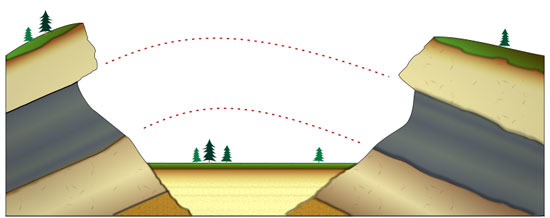Principle of Lateral Continuity
There is one final principle of relative dating that you need to learn about, and then you will get a chance to put your skills to the test and assign relative ages to some sample rock strata.

This final principle is called the principle of later continuity. It was first described by Nicolaus Steno and is well illustrated in the diagram here. It tells us that sediment initially extend laterally in all directions and are laterally continuous when they are first laid down. Rocks that are otherwise similar but that are separated by a valley or other erosional feature can be assumed to be of the same origin and of the same age.
Consider the rocks in the diagram above. What could cause the valley that cuts through the layers?
The valley is a result of weathering and erosion, perhaps from the running water of a river or from the flow of a glacier.
Which is older, the valley or the rock layer on the bottom of the sides?
The rock layer on the sides is older. It had to have been laid down before the valley was cut through the rock layers. You know this by the principle of superposition.
Suppose the valley in the diagram is 25 miles wide. What does the principle of lateral continuity tell you about the rocks that make up the top layer on both sides of the valley?
The principle of lateral continuity tells you that the rocks are of the same age.